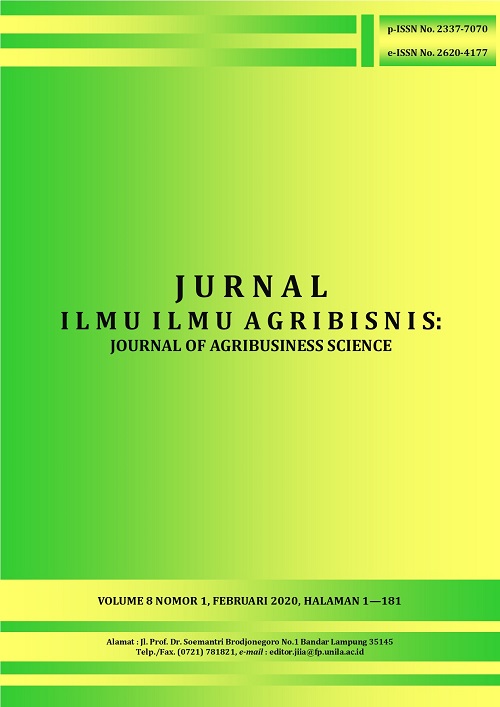KINERJA DAN NILAI TAMBAH AGROINDUSTRI SAGU AREN DI KABUPATEN LAMPUNG SELATAN
DOI:
https://doi.org/10.23960/jiia.v8i1.4359 Abstract View: 905
Abstract View: 905
Abstract
This study aimed to analyze the raw material procurement system based on six components, the performance and the added value of the palm sago agro-industry in Natar subdistrict of South Lampung Regency. The research was a case study in which location was chosen purposively in four Sago Aren Agroindustries by considerating that there were only four agro-industries that were still actively producing sugar palm sago in that area. The reseach data collection was conducted in March - April 2018 and analyzed by qualitative and quantitative descriptive and added value analysis. The results showed that the six components of raw material procurement namely time, place, quality, organization, quantity, and price in Sago Aren of Adi Putra, Oblak, and Surahmat Agroindustries were appropriate because they have been in line with expectations. There was still a component of material procurement standards that have not been matched or did not in line with the expectation in Kartim Agroindustry namely quantity. Production performance in the Sago Aren Agroindustries could be classified as good, because four of the five indicators in production performance namely productivity, capacity, quality, and speed of delivery were appropriate, while indicators of flexibility in the four sago palm agroindustry was not optimal, and the four sago palm agroindustry was feasible because it provided positive added value.
Key words: sagu aren, performance, value added
Downloads
Downloads
Published
How to Cite
Issue
Section
License
Authors who publish with this journal agree to the following terms:
Authors retain copyright and grant the journal right of first publication with the work simultaneously licensed under a Creative Commons Attribution License that allows others to share the work with an acknowledgement of the work's authorship and initial publication in this journal.
Authors are able to enter into separate, additional contractual arrangements for the non-exclusive distribution of the journal's published version of the work (e.g., post it to an institutional repository or publish it in a book), with an acknowledgement of its initial publication in this journal.
Authors are permitted and encouraged to post their work online (e.g., in institutional repositories or on their website) prior to and during the submission process, as it can lead to productive exchanges, as well as earlier and greater citation of published work (See The Effect of Open Access).














